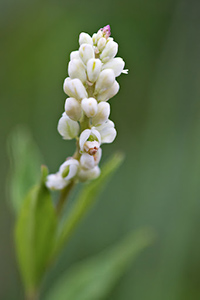Table of Contents
The ancient Greeks fed their cattle senega snakeroot to increase milk production, which is why they gave the European species of this plant the name polygala (poly = much; gala = milk). Snakeroot has been employed in Europe for a long time with this aim, given to cattle and goats, but with doubtful success.
- We produced this extract using a classic maceration method of extraction to ensure that the broad spectrum of therapeutic plant compounds – vitamins, minerals, alkaloids, flavonoids and other active constituents of the herbs are fully extracted and maintained.
At the same time, American natives historically have used another species of the genus polygala: senega snakeroot (Polygala senega L.), which has a composition similar to that of the European species, to treat snake bites and respiratory afflictions.
Interestingly, the present pharmaceutical research has proved that American natives are suitable. Senega snakeroot is part of many pharmaceutical medicines for bronchial and lung disorders.

Senega Snakeroot Scientific Facts
- Other names: Seneca snakeroot, milkwort, mountain flax.
- French: Polygala.
- Spanish: Poligala.
- Environment: Rocky soils of eastern North America. This plant is farmed in other parts of the world as a medicinal herb.
- Description: This is a vibrant plant of the Polygalaceae family. It has a ground, evergreen stem from which some herbaceous stems grow up to 30 cm high. The tip of these stems has little bluish, pink, or white flowers. It has a sour flavor.
- Parts of the plant used medicinally: The whole plant, especially its root.
Healing Properties and Indications

The whole plant, especially its root, is rich in saponins, vegetal substances that, like soap, produce foam in contact with water since they decrease its surface tension. The main saponins in senega snakeroot are polygalic acid and senegine, two substances that increase the secretions of the bronchi.
All these substances thin the pathogen mucus of the bronchi, making it foamier and more abundant, easing its expulsion and regenerating the respiratory mucous membrane.
Senega snakeroot is a purely mucolytic and expectorant plant. It is recommended for bronchitis, bronchial catarrh, bronchial asthma, pneumonia, pharyngitis, the flu, and cough. Senega snakeroot also has laxative properties due to its saponin content and emetic (vomit-producing) properties in high doses.
How to use Senega Snakeroot
- Decoction with five to ten grams of leaves or ground root per liter of water, boiling for three minutes. Drink three or four cups daily, sweetened with honey.
- Root powder: The recommended dose is from 0.5 to 2 g daily.

European Snakeroots
Several species of the genus Polygala have a similar composition, though the senega species is the most employed due to its richness in active components. There are two species of this genus in Europe.
- Polygala amara L., which grows in northern Europe and western Asia.
- Polygala rupestris Pourr., which grows in the southern regions of Europe.
Frequently Asked Questions
What are the primary active compounds in Senega snakeroot?
Senega snakeroot contains several potentially beneficial constituents, including:
Senecine and senegine: Pyrrolizidine alkaloids (PAs)
Polygalic Acid: A saponin
Essential Oils: Including components like borneol and camphor
How might it support respiratory health?
Traditionally, it has been used as an expectorant, potentially helping loosen mucus and aiding in coughs or congestion. Some studies suggest polygalic acid might have anti-inflammatory effects relevant to respiratory conditions.
Are there studies on the plant’s use for arthritis?
Limited research suggests potential anti-inflammatory properties relevant to joint health.
What are the concerns regarding this plant’s pyrrolizidine alkaloids (PAs)?
PAs are known for potential liver toxicity, especially with long-term or high-dose use. Using snakeroot under professional guidance and for limited durations is essential.
Can snakeroot interact with medications?
Yes. Potential interactions exist due to snakeroot’s effects on the liver and its potential impact on how the body processes certain medications. Always consult your doctor before combining snakeroot with any medication.
Are there documented cases of snakeroot toxicity?
Yes, cases of liver toxicity (hepatic veno-occlusive disease) have been associated with the use of plants containing PAs, including this one. This underscores the need for caution and professional guidance.
What are the traditional uses of aside from respiratory and joint health?
It has been used historically in various traditional medicine systems for conditions such as:
Menstrual irregularities
Snakebites (hence the name)
As a mild stimulant
Is there sufficient scientific evidence to support all the traditional uses?
No. While some potential benefits are being investigated, many traditional uses lack scientific solid backing. More research is needed.
What forms of the plant are typically used?
Teas
Capsules
Tinctures
Where can I find reliable information on dosages and safety?
Consult a qualified healthcare professional with experience using Senega snakeroot, such as a naturopathic physician or clinical herbalist. They can advise on appropriate dosages and potential contraindications for your health condition.
DISCLAIMER: All content on this website is presented solely for educational and informational objectives. Do not rely on the information provided as a replacement for advice, diagnosis, or treatment from a qualified medical expert. If you are pregnant, nursing, or have any preexisting medical concerns, talk to your doctor before using any herbal or natural medicines.
REFERENCES
- George D. Pamplona-Roger, M.D. “Encyclopedia of Medicinal Plants.” George D. Pamplona-Roger, M.D. Encyclopedia of Medicinal Plants. Ed. Francesc X. Gelabert. Vols. 1 San Fernando de Henares: Editorial Safeliz, 2000. 327. Print.
- National Institutes of Health (NIH): https://www.nih.gov/
- Memorial Sloan Kettering Cancer Center: https://www.mskcc.org/cancer-care/diagnosis-treatment/symptom-management/integrative-medicine/herbs
- WebMD: https://www.webmd.com/
Last update on 2024-07-21 / Affiliate links / Images from Amazon Product Advertising API






